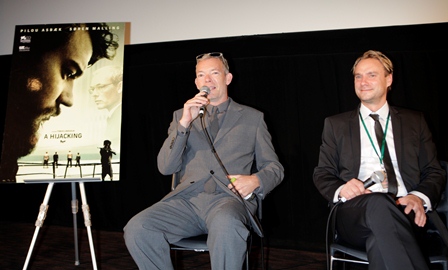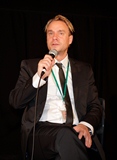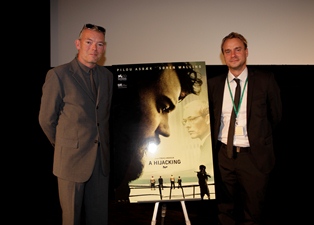10/20 (Sat) Q&A Session of A Hijacking – Competition film was held with Søren Malling (Actor) and Tomas Radoor (Producer).

I heard this is your first time in Japan? May we have few words for the audience?
Søren Malling: My name is Søren Malling, the actor, and first of all I would like to thank you all for inviting me and my friend Tomas, the producer, we are very happy to be here. We’ve spent 20 hours to come here from Denmark by plane. I hope you enjoyed the film. I am looking forward to your questions.

Tomas Radoor : Thank you for inviting us and we are delighted to be here. It was a long trip but we are so happy to present the film for you.

Q: I felt that the film was very intense and I really enjoyed it.
My question is about Omar. He claims to be a negotiator, not one of the pirates, but watching him, he reminded me of a leader of pirates. My question is whether pirates really use such tactics of hiring the negotiators or was Omar leader of the pirates?
Tomas: In real life nobody knows. Some of pirates use such tactics because it is easier for them. I mean the FBI has already traced such people that do that kind of business. It is used in real life. The dramatic sense is set in the film that Omar is not one of the pirates and is a negotiator. We added this character to bring out the sense of crisis.
Q: I work in the shipping company and understand that it is rare to see dramas depicting shipping company or such situation in Japan. I assume that the real Somalian pirates are more brutal and cruel to hostages. I would like to know whether you made the situation rather mild, opposing to the reality, considering the people in Denmark who are involved in shipping business or who are their families.
Tomas: I think we have authentically depicted the actual hijacking of the ship in film. The conditions that men are shown in are actually the way seamen are hijacked in real life. We shot the film in Kenya and actually sailed out in Indian Ocean. The boats we rented were actually hijacked couple of years ago and some the sailors working on the ship were also hijacked. So we had witnesses who experienced the hijack. We also showed the film to Danish seaman who were actually hijacked and they all approved that it was depicted closely to reality.
Q: Was the real seaman in the film as well?
Tomas: Søren played the CEO and Johan Philip Asbæk played one of the seamen and engineer of the ship is played by Rolland Møller. But most of the other casts are actually seaman in real life. Most of them were amateurs who were seamen.
Were the pirates real as well?
Tomas: No we didn’t hire the actual pirates; Somalians who played the pirates were casted from Somalia community in Kenya and were actually scouted from the streets.
Q: Is this film based on a true story? Did you meet the person who worked as the head of the Shipping Company who actually had been hijacked? How much of this was reflected in the film and how did you reflect it on your acting?
Malling: It’s not based on the real story but it is inspired by the several hijacking incidents that took place in last 10 years. I spent many hours talking with the CEO of shipping company in Copenhagen which allowed me to accompany him at work and allowed me to watch how he talked, d walked and dressed.
I actually had a chance to talk to him about a situation he was in few years ago when he was trying to get the seaman back home. He had actually got the telephone calls from the pirates and a negotiator from down south in Kenya. When I asked how he felt about it, he almost cried and said he didn’t want to talk about it. But this was a very inspiring experience for me because I think that the character of Peter C. Ludvigsen in the film is a person with responsibility for the seaman, he wants to actually get them back alive and not in the body bag. He takes us to the emotional journey like a roller coaster by showing him in the situations where he almost cracks as a human being.
Q: I want to ask about the scenes that were shot in the ship. How far from the shore was the ship and also how many days did it take to shoot the film?
Tomas: We went to Kenya at 2 weeks of preparation and we shot for 3 weeks in Kenya at the ship and we had 4 sailing days filming in the Indian Ocean. I don’t know how far out but far enough to be hijacked. That is why we had 6 armed guards from Kenyan police. The director was having coffee when he overheard the conversation from the guards. When guards loaded the AK47 automatic rifle, they put the full metal jacket bullet first, and then change to hollow point bullet afterwards because if you shoot the Somalian pirates, they are so skinny that the bullets will thrash their guts. Hearing that, the director became scared and went back shaking to the shooting set. I felt that filming in the Indian Ocean is coming to the nearest thing to being hijacked.




















